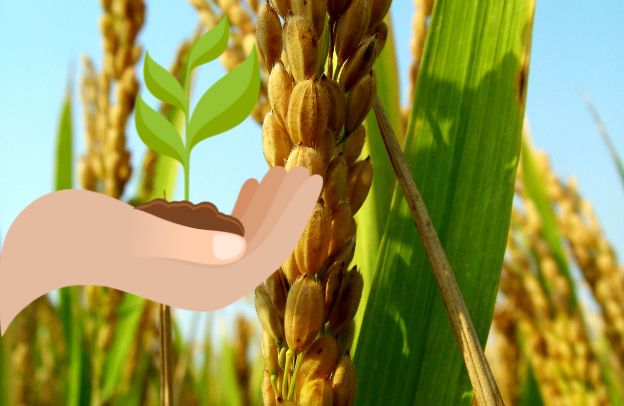Rice Beyond the Plate: Unlocking Nigeria’s Potential in Cosmetics and Skincare

When you think of rice, your mind likely drifts to steaming bowls of jollof rice or fragrant basmati. But did you know that this humble grain holds immense potential beyond the dinner table? Across Asia, rice has been a skincare secret for centuries, and the global beauty industry is now catching on. Nigeria, as Africa’s largest rice producer, has a unique opportunity to tap into this billion-dollar industry. Could rice-based cosmetics be the game-changer Nigeria’s agricultural sector needs?
Learn How to Leverage Your Story through our Story to Asset Framework.
For the African diaspora looking to invest in sustainable and high-value agribusiness, the intersection of rice production and skincare presents an untapped market brimming with opportunities. From rice bran oil to rice starch, Nigerian farmers and entrepreneurs can position themselves at the forefront of the beauty industry’s next big wave.
Rice Production in Nigeria: An Agricultural Powerhouse
Nigeria leads Africa in rice production, with over 5.4 million metric tons produced annually (United States Department of Agriculture, 2023). However, the country still relies heavily on imports to meet its growing demand. Most discussions about rice revolve around food security, yet a significant portion of this staple particularly rice bran, husk, and starch remain underutilized.
Rice bran, which constitutes about 10% of the grain’s weight, is often discarded or used as animal feed (FAO, 2022). However, in global beauty markets, it is a sought-after ingredient in anti-aging creams, exfoliators, and serums. In Japan, where rice has long been used for skincare, the demand for rice-based cosmetics has fueled a $2 billion industry (Statista, 2023). What if Nigeria could harness its rice byproducts in the same way?
Why Rice Bran is a Game-Changer in Skincare
1. Rich in Skin-Loving Nutrients
Rice bran is packed with Vitamin E, ferulic acid, and gamma-oryzanol, all of which are powerful antioxidants that protect the skin from free radicals. Studies have shown that rice bran oil improves skin hydration, reduces wrinkles, and enhances elasticity (Journal of Cosmetic Science, 2021).
2. A Natural Brightening Agent
In Korea, rice water is a staple in beauty routines because of its brightening and anti-inflammatory properties. It helps fade hyperpigmentation, even out skin tone, and improve skin texture. Nigerian women, who are often concerned with hyperpigmentation due to high sun exposure, could greatly benefit from such locally made products.
3. Eco-Friendly and Sustainable
Unlike chemical-laden beauty products, rice-based skincare offers a sustainable and natural alternative. As global consumers become more environmentally conscious, demand for clean beauty products free of sulfates, parabens, and artificial additives is skyrocketing. The clean beauty market is projected to reach $15 billion by 2027(Market Research Future, 2023).
See also: Unlocking the Power of Rice: From Health Benefits to Economic Prosperity in Agribusiness
How Nigerian Farmers Can Tap Into This Market
Nigeria’s agricultural sector holds immense potential, yet many farmers remain unaware of the diverse opportunities available within global and local markets. By understanding trends, adopting new technologies, and focusing on sustainable practices, Nigerian farmers can tap into emerging markets for their produce, both domestically and internationally.
This shift could not only increase profitability but also drive agricultural growth, elevate rural economies, and enhance food security. Here’s how Nigerian farmers can harness these opportunities and thrive in today’s competitive market
1. Processing Rice Bran for Cosmetics
Most Nigerian rice mills focus on white rice production, leaving behind vast amounts of brain that go unused. By investing in rice bran oil extraction plants, entrepreneurs can create locally produced, high-value skincare ingredients for both domestic and export markets.
2. Partnering with Global Beauty Brands
Major skincare brands like Tatcha, KOSÉ, and The Body Shop already incorporate rice derivatives in their formulations. If Nigerian agribusinesses can meet international quality standards, they could become suppliers for these brands, much like how Ghana supplies raw shea butter to global beauty giants.
3. Training Farmers on High-Quality Production
Many farmers in Nigeria still use traditional methods that reduce the quality of rice byproducts. Training programs that teach proper milling techniques, storage methods, and organic farming practices can improve the quality of rice bran, making it more attractive to buyers.
The Role of the African Diaspora in Scaling Rice-Based Cosmetics
Members of the African diaspora play a crucial role in transforming Nigerian agribusiness. With access to global markets, investment capital, and industry expertise, they can bridge the gap between local producers and international consumers.
- Investing in Processing Facilities: Diaspora entrepreneurs can fund rice oil extraction plants, milling facilities, and research centers to improve product quality. The Diaspora Investment Fund by Afreximbank provides financing opportunities for Africans abroad looking to invest in agriculture.
- Exporting Nigerian Rice-Based Beauty Products: There is growing interest in Afrocentric beauty products abroad, particularly in the United States and Europe. Diaspora entrepreneurs can establish distribution channels in these markets, leveraging the appeal of “Made in Africa organic beauty products.
- Supporting Policy Advocacy for Agribusiness: Lobbying for better government policies, tax incentives, and infrastructure development can make Nigeria’s agribusiness environment more investment-friendly. The Nigerian Investment Promotion Commission (NIPC) offers guidance on agricultural investment opportunities.
Case Study: Japan’s Rice-Based Skincare Industry
Japan has long embraced rice as a skincare ingredient, with major brands like KOSÉ and Tatcha leading the market. According to a 2022 report by Euromonitor, Japan’s rice-based beauty industry generates over $2 billion annually.
By adopting similar practices, Nigeria could create a parallel industry, utilizing its abundant rice production for both food and beauty.
Challenges and Solutions:
While the opportunities for using rice in cosmetics and skincare are vast, several structural, regulatory, and market-related challenges must be addressed to fully capitalize on this potential. Below, we examine key challenges and propose practical, actionable solutions for entrepreneurs, investors, and policymakers.
Lack of Processing Infrastructure
Challenge:
Nigeria’s rice milling sector is largely focused on food production, with most mills designed to separate rice grains from husks, leaving valuable byproducts, such as rice bran and rice husks, underutilized.
Currently, fewer than 10% of Nigeria’s rice mills have the capacity to extract high-quality rice bran oil (RBO) or process rice starch for industrial use (Nigerian Institute for Agricultural Research, 2023). The absence of modern oil extraction and purification technologies makes it difficult for Nigeria to compete with leading global producers like Japan, India, and Thailand, where rice-derived skincare ingredients are extracted with advanced refining techniques.
Additionally, the short shelf life of raw rice bran presents a problem. Once separated from the rice kernel, bran starts to oxidize quickly, losing its essential nutrients and making it unsuitable for cosmetic formulations.
This issue is compounded by poor storage and transportation infrastructure, leading to high post-harvest losses.
Solution:
Invest in modern milling and oil extraction plants: Diaspora investors and agribusiness entrepreneurs can establish rice oil processing plants equipped with cold-press extraction, solvent extraction, and enzymatic refining technologies. These methods preserve the nutrient integrity of rice bran oil, making it a premium ingredient for skincare formulations.
Government incentives and funding support: The Nigerian Export Promotion Council (NEPC) offers grants and tax incentives for businesses exporting value-added agricultural products. Diaspora investors can access these programs to reduce capital investment costs.
Public-private partnerships for infrastructure development: Collaborations between the government and private enterprises can help fund storage and transportation networks, ensuring that rice bran reaches processing centers in optimal condition. Cooling storage units and vacuum-sealed packaging can extend the shelf life of raw bran, preserving its nutrient content for cosmetic production.
Poor Quality Control and Regulatory Standards
Challenge:
For Nigeria to successfully export rice-based cosmetic ingredients, it must comply with international safety and quality standards. Currently, there are no specific regulatory frameworks governing the production of rice-derived beauty products in Nigeria.
Unlike Japan and Korea, where rice bran oil is refined to meet pharmaceutical-grade purity levels, Nigerian rice processing is highly inconsistent, leading to concerns about contamination and product quality.
Without standardized extraction and purification techniques, Nigerian rice bran oil risks being rejected by global buyers due to high levels of impurities, microbial contamination, or rancidity. Moreover, cosmetics containing low-quality or unregulated ingredients may not meet certification requirements in the EU and U.S. markets, making them difficult to sell abroad.
Solution:
- Establish industry-specific quality control standards: Nigerian regulatory agencies like the Standards organization of Nigeria (SON) and NAFDAC should create clear guidelines for producing, refining, and certifying rice-derived skincare ingredients. These guidelines should align with international standards such as ISO 16128 for natural cosmetics and EU REACH regulations for cosmetic safety.
- Collaboration with research institutions: The Nigerian Institute for Oil Palm Research (NIFOR) and agricultural universities can provide technical training to rice processors, teaching them best practices for oil extraction, purification, and formulation.
- Third-party certifications for export markets: Nigerian businesses should seek organic and halal certifications, which increase the credibility of their products in high-value markets like Europe, the Middle East, and North America. Partnering with certification bodies such as Ecocert and the U.S. FDA can enhance the marketability of Nigerian rice-based skincare products.
Limited Awareness Among Farmers and Local Entrepreneurs
Challenge:
Despite Nigeria’s large rice production base, most Smallholder farmers and rice millers are unaware of the lucrative potential of rice bran and rice starch in cosmetics.
Over 70% of Nigerian rice farmers operate on small-scale farms (National Bureau of Statistics, 2023), with little knowledge about value addition. Instead of processing rice byproducts for skin care applications, farmers either discard them as waste or sell them cheaply as livestock feed.
Additionally, there is little to no integration between Nigeria’s agricultural sector and its emerging beauty and cosmetics industry. Many local entrepreneurs in cosmetics import their raw materials from Asia and Europe, unaware that high-quality rice-based ingredients can be sourced domestically.
Solution:
Educational programs and training workshops: Government agencies, agribusiness incubators, and NGOs should launch training initiatives to educate farmers and small-business owners on the economic value of rice byproducts.
Programs such as “From Farm to Face” could bridge the gap between agriculture and skincare, teaching farmers how to process and package rice-based ingredients for local and export markets.
Integration with Nigeria’s growing beauty industry: The Nigerian beauty sector is worth over $1 billion annually (Statista, 2023). By connecting cosmetic manufacturers with rice processors, the country can establish a homegrown supply chain that reduces dependence on imported ingredients.
Leveraging social media and digital platforms: Digital marketing campaigns, YouTube tutorials, and influencer partnerships can promote awareness of Nigerian rice-based beauty products. Highlighting success stories of local entrepreneurs using rice bran in skincare could inspire more farmers and investors to enter the market.
Market Penetration and Brand Positioning
Challenge:
Even with high-quality products, Nigerian rice-based cosmetics will struggle to compete against well-established international brands.
Consumers often trust foreign beauty products over locally made alternatives, leading to a preference for Japanese, Korean, and European skincare brands. Additionally, there is limited brand visibility for Nigerian beauty products in global e-commerce and retail markets.
Solution:
Brand storytelling and product differentiation: Nigerian beauty brands can emphasize their use of African-grown rice, positioning their products as natural, organic, and ethically sourced. Leveraging the heritage of African beauty traditions similar to how shea butter brands market their products can help rice-based cosmetics stand out.
Export opportunities through e-commerce platforms: Nigerian entrepreneurs should leverage platforms like Amazon, Etsy, and Alibaba to sell rice-based beauty products internationally. Partnering with diaspora-owned businesses in the U.S. and U.K. can expand distribution networks.
Collaborations with African diaspora beauty influencers: Many influencers and skincare experts in the diaspora are promoting Afrocentric and clean beauty brands. Partnering with these influencers can increase visibility and drive global demand for Nigerian-made rice cosmetics.
While Nigeria faces significant infrastructure, regulatory, and market challenges in producing rice-based cosmetics, targeted investments, policy improvements, and industry collaboration can create a thriving new sector. By addressing these obstacles, Nigeria can diversify its agribusiness sector, create jobs, and boost non-oil exports.
With the support of diaspora investors, forward-thinking entrepreneurs, and proactive government policies, Nigeria can become a leader in the global natural beauty industry all while transforming what was once considered a simple byproduct into a high-value commodity.
For those looking to invest in an innovative, high-growth industry with sustainability, profitability, and global appeal, Nigeria’s rice-based skincare market offers an unparalleled opportunity.
See also: African Rice Evolution and Technology: Building a Legacy of Collaboration, Innovation
Conclusion: The Future of Nigerian Rice in Beauty
Rice is more than just food; it’s an economic powerhouse waiting to be unlocked. The Nigerian agricultural sector, often associated with subsistence farming, has the potential to become a global supplier of high-value beauty ingredients.
By embracing innovation, investing in processing facilities, and leveraging diaspora expertise, Nigeria can transform its rice industry into a multi-billion-dollar enterprise.
For African diaspora investors looking to make a meaningful impact while achieving financial success, this is an opportunity worth seizing. Will you be part of the movement to redefine Nigerian agribusiness?
(Learn How to Leverage Your Story through our Story to Asset Framework.)





